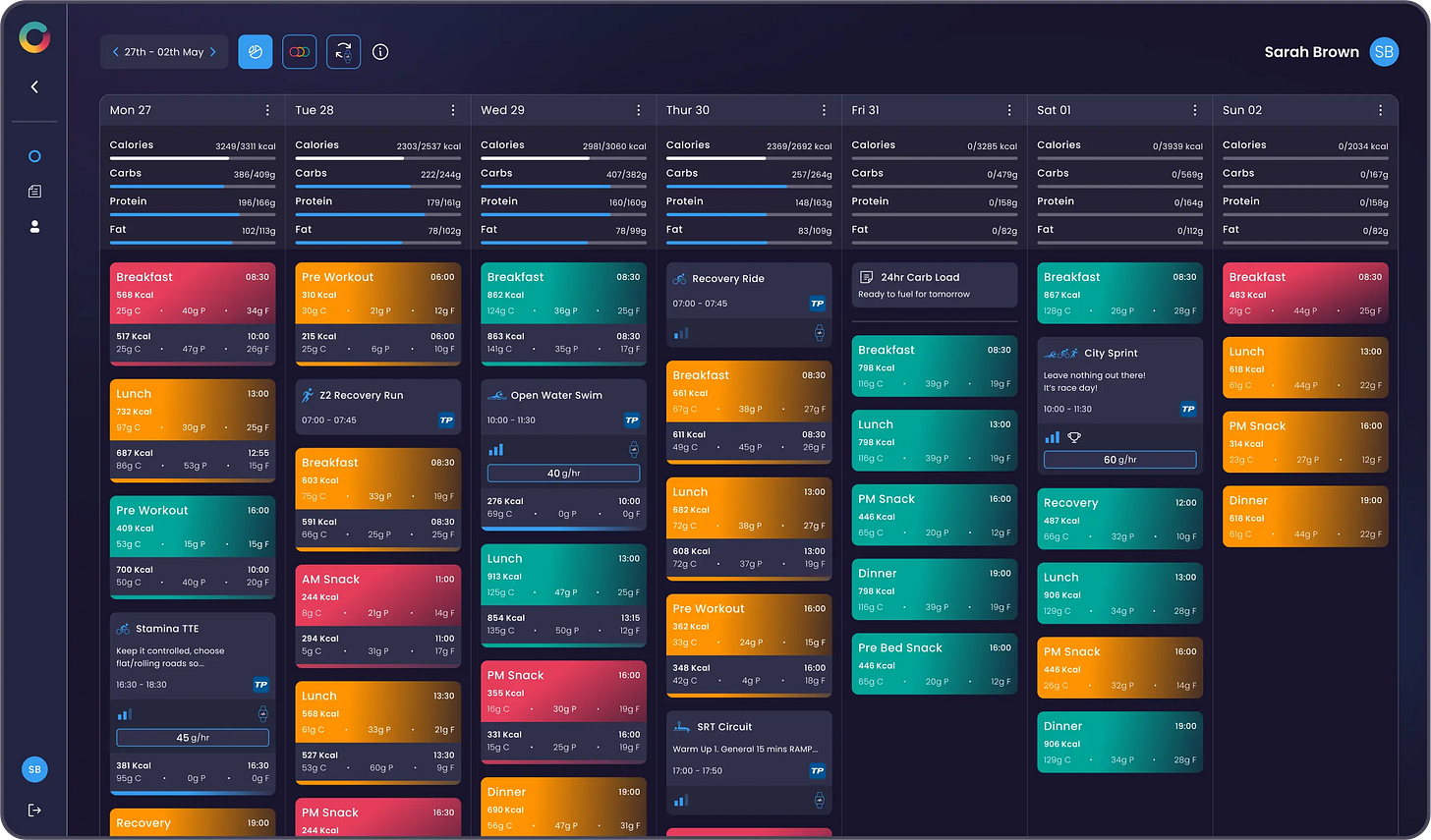Beyond the Static Template: Scaling Personalised Nutrition Through Intelligent Replanning
Leveraging Technology to Free Nutritionists to Focus on Coaching, Not Spreadsheets
After years of studying what over 1,000 athletes across 15+ elite sports want from nutrition technology, as well as how they as individuals want to interact with the technology, one pattern emerged consistently: static plans fail. Why? Life just happens. Training ran over. The schedule got changed. You slept in late. Your PDFs and templates can think. Static plans fail because life isn't static.
The Science Behind Effective Planning
First, let's be clear: having a plan is absolutely critical. Decades of psychology research, particularly Peter Gollwitzer's groundbreaking work on implementation intentions, demonstrates that people who make specific plans about how they'll perform a behaviour are significantly more likely to follow through than those who simply set goals.
people who make specific plans about how they'll perform a behaviour are significantly more likely to follow through
This planning approach is formally recognised in behaviour change literature as Action Planning (behaviour change technique 1.4). For athletes, this translates to creating specific fuel plans contextualised around training: "If training finishes at 3pm, then I'll consume a post-training meal at 3.15pm containing 30g of protein and 60g of carbohydrates from food X and drink Y at the training centre."
This pre-commitment removes decision-making friction at crucial moments when willpower may be low. This is particularly vital for athletes, who face unique cognitive pressures and time constraints that can compromise their capacity for optimal nutrition decision making precisely when those decisions matter most.
But why does creating a plan work so effectively? The Theory and Techniques Tool, developed through a comprehensive synthesis of 277 behaviour change studies involving 2,636 technique-mechanism links, identified that action planning works through behavioural cueing: processes by which behaviour is triggered from either the external environment, the performance of another behaviour, or from ideas appearing in consciousness.

But here's the problem: traditional static nutrition plans create action plans that become irrelevant the moment reality deviates from the plan.
The Problem with Static Nutrition Plans
Traditional nutrition approaches give you a plan and expect you to follow it perfectly. Train for 90 minutes instead of 60? Too bad, your macronutrient targets remain unchanged. Eat a larger breakfast than planned? The PDF or template doesn't adjust your lunch accordingly.
This rigidity creates a cascade of problems that plague sports nutrition departments worldwide. Athletes typically abandon their plans after the first (and practically guaranteed) deviation, creating a practitioner-dependent bottleneck where players cannot generate updated nutrition plans without direct nutritionist input. This forces practitioners to spend countless hours manually recalculating plans using spreadsheets, time that should be spent athlete-facing rather than trapped behind administrative tasks.
Most critically, training data from all athletes (GPS, power, HR, etc) remains completely disconnected from nutrition planning systems. The result? An untapped competitive advantage where personalised nutrition can only scale to a handful of "priority" athletes, leaving the majority with generic guidelines precisely when crucial training blocks and recovery periods demand the most individualised support.
How Replanning Works
Hexis's replanning feature solves this through continuous recalibration. Every planned meal or logged snack triggers an assessment: are you under or over fuelling, and which macronutrients are above or below your targets? So, if Hexis planned 25g of protein at breakfast for you but you grabbed a couple of extra eggs and hit 35g+, no problem. In milliseconds, Hexis automatically adjusts your remaining meals and snacks to keep you on track, ensuring optimal nutrient periodisation throughout the day. Guesswork removed.
The same applies to training. Complete a harder session than planned? Hexis recalibrates your post-workout recovery nutrition based on actual energy expenditure and session data in real-time. Train longer? Shorter? Skip a session? You're covered, your nutrition plan adjusts accordingly, instantly.
This, as illustrated in the above video, creates truly adaptive nutrition: a plan that evolves with your day, rather than getting left behind.
The Compound Effect for Athletes
For athletes, replanning enables something revolutionary: compounding performance benefits meal by meal. Instead of one deviation derailing your entire day, each meal becomes an opportunity to optimise fuelling, recovery and adaptation according to your most current physiological state and needs.
This matters because athletic performance operates on incremental and consistent gains. When nutrition is used as a performance tool and optimised meal by meal across weeks, months and years, the compounding result is significant and measurable performance enhancements.
Scaling Personalisation for Practitioners
For practitioners, replanning solves a major scalability challenge of personalised nutrition. Rather than manually adjusting plans throughout the day, an impossible task when working with squads, you can invest in technology as infrastructure to transform manual processes into scalable personalisation systems that improve efficiency, capacity and productivity.
Let me illustrate this for you. You’re the Lead Nutritionist for the Senior Squad, 30 of them, one of you. It’s 8.47am. Three athletes decided to come in early and do some extras. Five athletes decided to have breakfast at home instead of the menu you prepared at the training centre. The rehab group session got moved from 10am to 1pm. To top it off, the coach has also made a last minute tweak to today's training loads. With Hexis, every change triggers instant adjustments for all the affected athletes.

The result? Personalised services at scale, enhanced athlete experiences and an elevated standard of care across the organisation. This frees practitioners to focus on what matters most: having meaningful conversations, building relationships, and having the time and capacity to actually coach their athletes' nutrition. In essence, doing what humans were designed to be great at.
The Future of Personalised Sports Nutrition
Replanning represents a fundamental shift from static to dynamic nutrition. It acknowledges that elite performance demands more than a PDF or template, it requires nutrition that adapts in real-time to each individual athlete's ever-changing needs.
I’ll leave you with this question: Are your manual processes the bottleneck holding back your athletes' performance?


